Top Rankings
Northeast Metro 916 School District ranks among the top 20% of public school district in Minnesota for:
Category
Attribute
Diversity
Most diverse schools (Top 1%)
Student Attention
Lowest student:teacher ratio (Top 1%)
For the 2025 school year, there are 10 public elementary schools serving 346 students in Northeast Metro 916 School District. This district's average elementary testing ranking is 1/10, which is in the bottom 50% of public elementary schools in Minnesota.
Public Elementary Schools in Northeast Metro 916 School District have an average math proficiency score of 13% (versus the Minnesota public elementary school average of 47%), and reading proficiency score of 20% (versus the 51% statewide average).
Minority enrollment is 49% of the student body (majority Black), which is more than the Minnesota public elementary school average of 40% (majority Black and Hispanic).
Overview
This School District
This State (MN)
# Schools
17 Schools
1,655 Schools
# Students
841 Students
571,925 Students
# Teachers
180 Teachers
40,363 Teachers
Student : Teacher Ratio
5:1
5:1
District Rank
Northeast Metro 916 School District, which is ranked within the bottom 50% of all 522 school districts in Minnesota (based off of combined math and reading proficiency testing data) for the 2021-2022 school year.
The school district's graduation rate of 41% has increased from 27% over five school years.
Overall District Rank
#501 out of 527 school districts
(Bottom 50%)
(Bottom 50%)
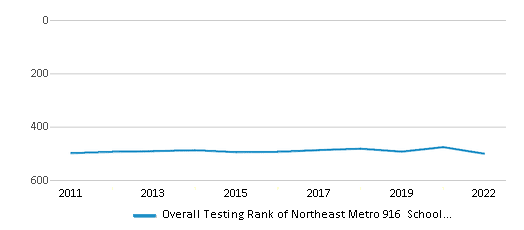
Math Test Scores (% Proficient)
11%
45%

Reading/Language Arts Test Scores (% Proficient)
18%
51%
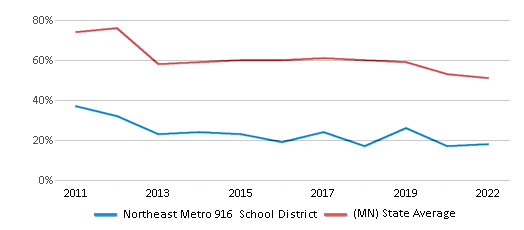
Science Test Scores (% Proficient)
10-14%
41%
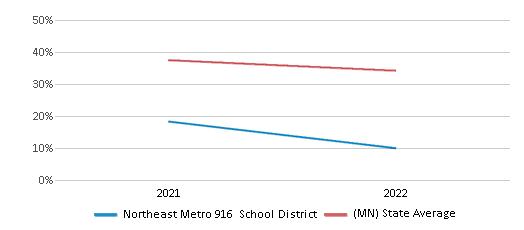
Graduation Rate
41%
84%
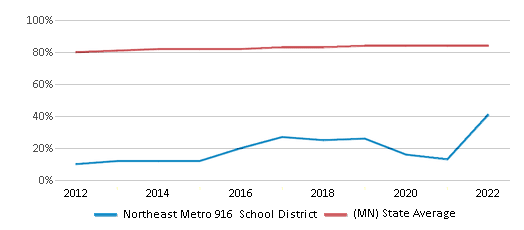
Students by Ethnicity:
Diversity Score
0.74
0.61
# American Indian Students
7 Students
10,480 Students
% American Indian Students
1%
2%
# Asian Students
69 Students
42,165 Students
% Asian Students
8%
7%
# Hispanic Students
130 Students
65,127 Students
% Hispanic Students
16%
12%
# Black Students
241 Students
70,794 Students
% Black Students
29%
12%
# White Students
321 Students
344,281 Students
% White Students
38%
60%
# Hawaiian Students
2 Students
676 Students
% Hawaiian Students
n/a
n/a
# Two or more races Students
71 Students
38,402 Students
% of Two or more races Students
8%
7%
Students by Grade:
# Students in PK Grade:
9
10,698
# Students in K Grade:
2
57,031
# Students in 1st Grade:
11
61,859
# Students in 2nd Grade:
25
63,560
# Students in 3rd Grade:
21
61,751
# Students in 4th Grade:
39
63,575
# Students in 5th Grade:
37
63,290
# Students in 6th Grade:
46
63,180
# Students in 7th Grade:
40
53,666
# Students in 8th Grade:
45
53,924
# Students in 9th Grade:
36
4,107
# Students in 10th Grade:
53
4,634
# Students in 11th Grade:
100
4,740
# Students in 12th Grade:
377
5,910
# Ungraded Students:
-
-
District Revenue and Spending
The revenue/student of $83,918 is higher than the state median of $17,854. The school district revenue/student has grown by 26% over four school years.
The school district's spending/student of $84,279 is higher than the state median of $18,580. The school district spending/student has grown by 26% over four school years.
Total Revenue
$71 MM
$15,547 MM
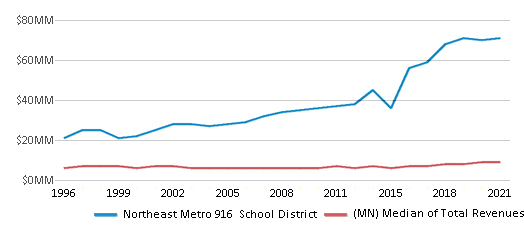
Spending
$71 MM
$16,179 MM
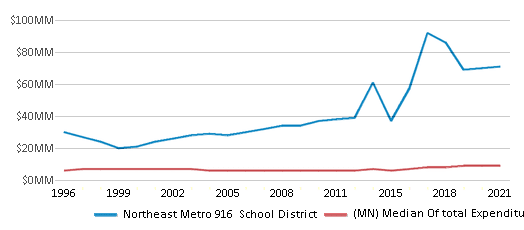
Revenue / Student
$83,918
$17,854
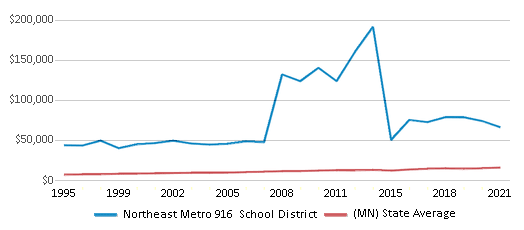
Spending / Student
$84,279
$18,580
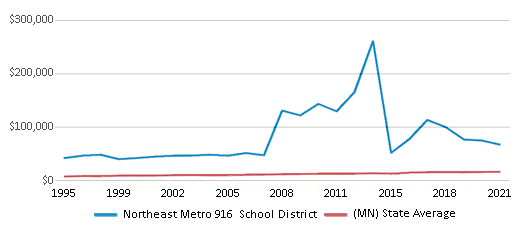
Best Northeast Metro 916 School District Public Elementary Schools (2025)
School
(Math and Reading Proficiency)
(Math and Reading Proficiency)
Location
Grades
Students
Rank: #11.
Willows
Alternative School
(Math: <50% | Reading: ≥50%)
Rank:
Rank:
7/
Top 50%10
10300 Flanders St Ne
Minneapolis, MN 55432
(651) 415-5364
Minneapolis, MN 55432
(651) 415-5364
Grades: 6-12
| 11 students
Rank: #22.
Bellaire Education Center
Special Education School
(Math: <50% | Reading: <50%)
Rank:
Rank:
7/
Top 50%10
2540 County Rd F
Saint Paul, MN 55110
(651) 415-5530
Saint Paul, MN 55110
(651) 415-5530
Grades: 5-9
| 26 students
Rank: #33.
South Campus Education Center
Special Education School
(Math: <50% | Reading: <50% )
Rank:
Rank:
6/
Top 50%10
3551 N Mcknight Rd
Saint Paul, MN 55110
(651) 415-5331
Saint Paul, MN 55110
(651) 415-5331
Grades: 5-12
| 59 students
Rank: #44.
Project Return
(Math: <50% | Reading: <50% )
Rank:
Rank:
4/
Bottom 50%10
2540 East County Road F
Saint Paul, MN 55110
(651) 415-5359
Saint Paul, MN 55110
(651) 415-5359
Grades: 6-12
| 1 students
Rank: #55.
Karner Blue Education Center
Special Education School
(Math: 10-14% | Reading: 15-19%)
Rank:
Rank:
1/
Bottom 50%10
3764 95th Ave Ne
Circle Pines, MN 55014
(651) 415-6201
Circle Pines, MN 55014
(651) 415-6201
Grades: K-9
| 102 students
Rank: #66.
Pankalo Education Center
Special Education School
(Math: 6-9% | Reading: 15-19%)
Rank:
Rank:
1/
Bottom 50%10
8568 Eagle Point Blvd
Lake Elmo, MN 55042
(651) 415-6302
Lake Elmo, MN 55042
(651) 415-6302
Grades: K-8
| 94 students
Rank: n/an/a
A/o Program
Special Education School
1111 South Holcombe St
Saint Paul, MN 55110
(651) 964-1274
Saint Paul, MN 55110
(651) 964-1274
Grades: PK-1
| 9 students
Rank: n/an/a
Aris
Alternative School
2040 Woodwinds Dr
Saint Paul, MN 55125
(651) 415-5364
Saint Paul, MN 55125
(651) 415-5364
Grades: K-12
| 33 students
Rank: n/an/a
Aris Currell
Alternative School
7616 Currell Blvd Ste 100
Saint Paul, MN 55117
(651) 415-5543
Saint Paul, MN 55117
(651) 415-5543
Grades: K-12
| 11 students
Rank: n/an/a
2540 East County Road F
Saint Paul, MN 55110
(651) 415-5359
Saint Paul, MN 55110
(651) 415-5359
Grades: K-12
| n/a students
Recent Articles

Year-Round Or Traditional Schedule?
Which is more appropriate for your child? A year-round attendance schedule or traditional schedule? We look at the pros and cons.

Why You Should Encourage Your Child to Join a Sports Team
Participating in team sports has a great many benefits for children, there is no doubt. In this article you will learn what those benefits are.

White Students are Now the Minority in U.S. Public Schools
Increasing birth rates among immigrant families from Asia and Central and South America, combined with lower birth rates among white families, means that for the first time in history, public school students in the United States are majority-minority. This shift in demographics poses difficulties for schools as they work to accommodate children of varying language abilities and socio-economic backgrounds.





